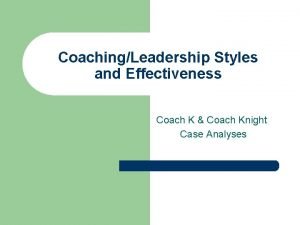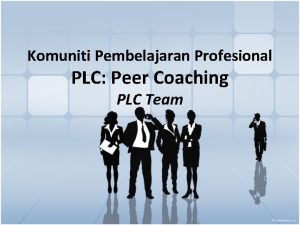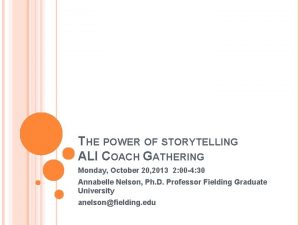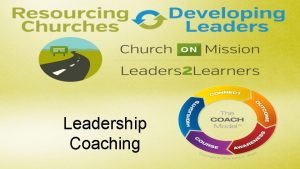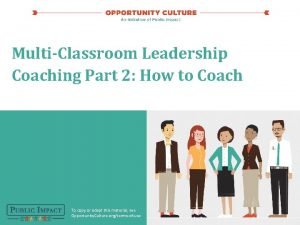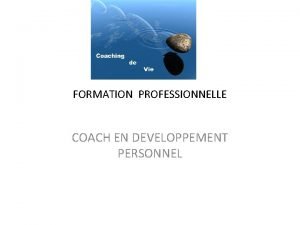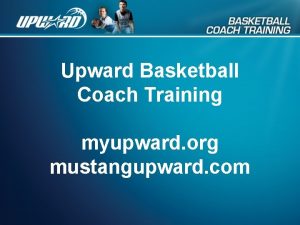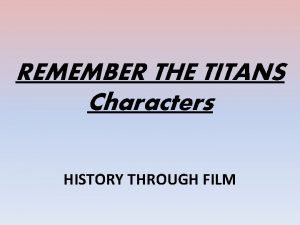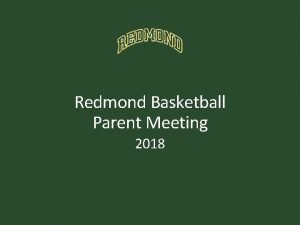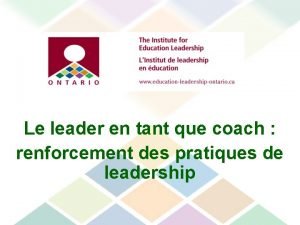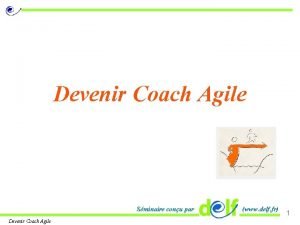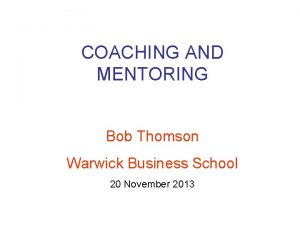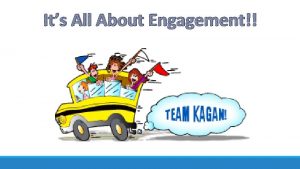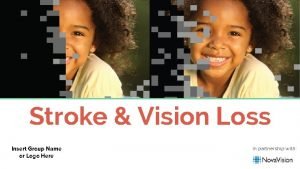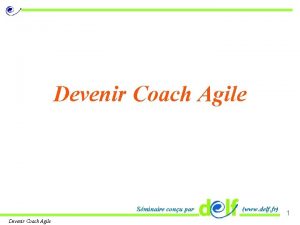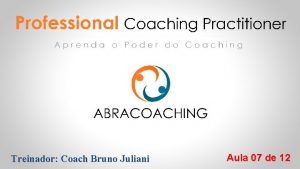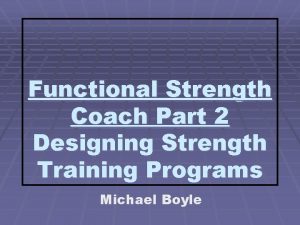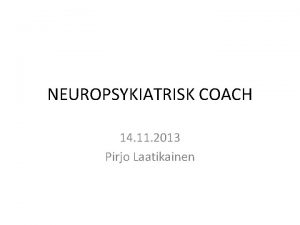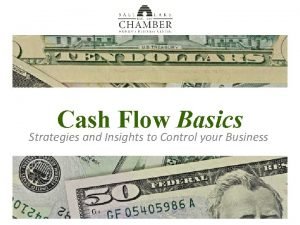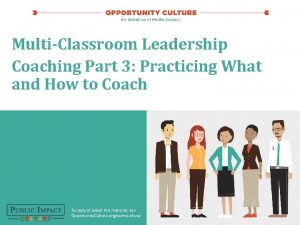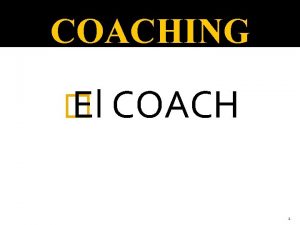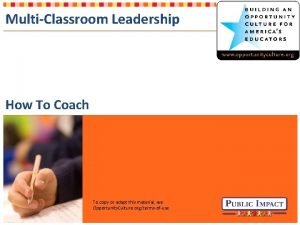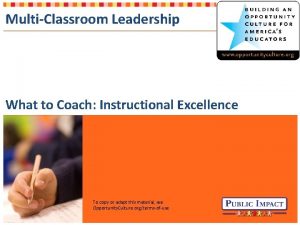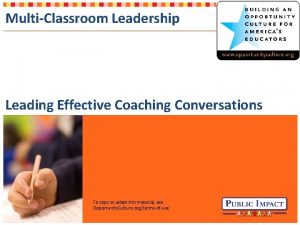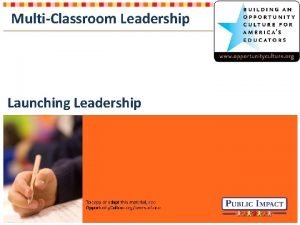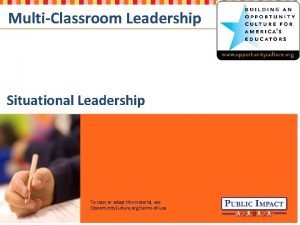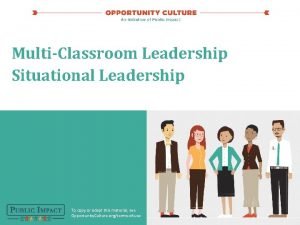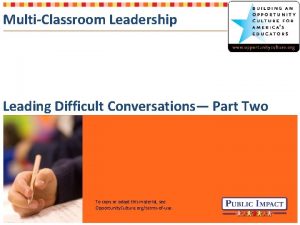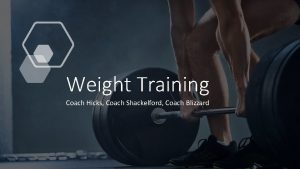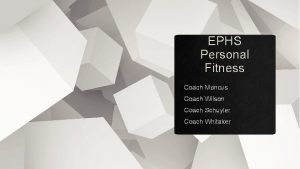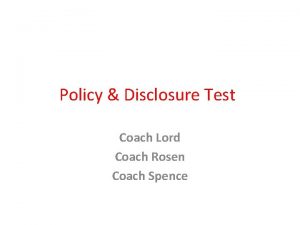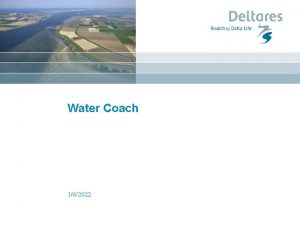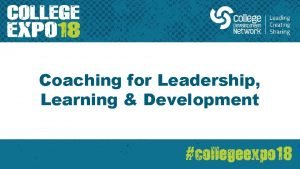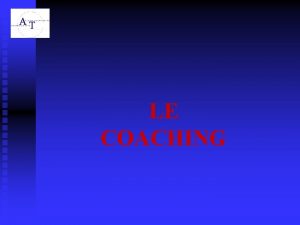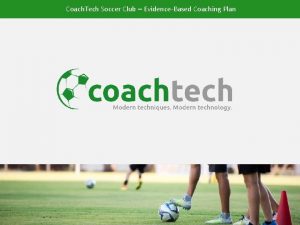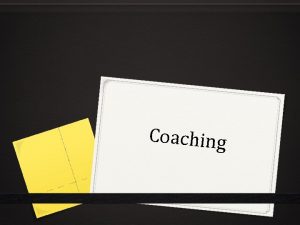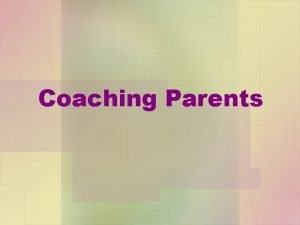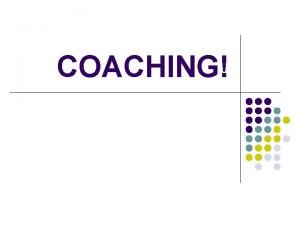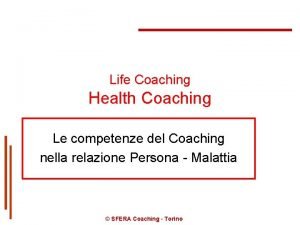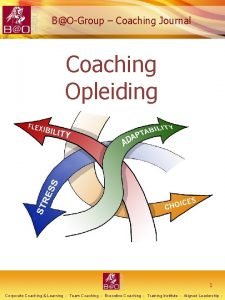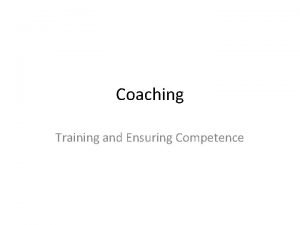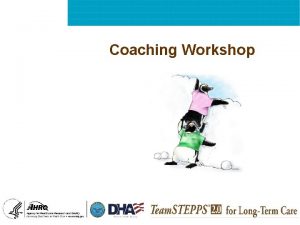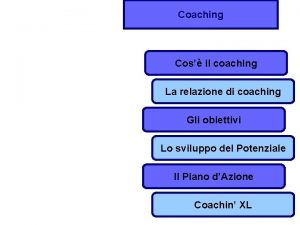MultiClassroom Leadership Coaching Part 2 How to Coach
































- Slides: 32

Multi-Classroom Leadership Coaching Part 2: How to Coach To copy or adapt this material, see Opportunity. Culture. org/terms-of-use 2019 |

Do Now In your experience being coached or coaching others, how would you define coaching? Time for this activity: 2 minutes 2019 | 2

Session Objectives • Define coaching and discuss the components of a coaching cycle. • Learn about tools used during informal observations and practice using tools. • Learn about and practice using a protocol for leading coaching conversations. 2019 | 3

What is Coaching? Coaching is professional development. Its purpose is to help an adult learner improve their practice. A coach is a facilitator of someone else’s learning. - Elena Aguilar, author of “The Art of Coaching” 2019 | 4

Feedback vs. Coaching What is the difference between feedback and coaching? What role can feedback play in coaching? Feedback Helps individuals be aware of strengths and areas of growth. Leads to acceptance that something needs to change. Coaching Helps individuals achieve the new goals that feedback helped them set. 2019 | 5

The Coaching Cycle Build relationship, set vision, and norm on roles and expectations Observe teaching, looking for implementation of action steps Facilitate debrief conversation to deliver feedback and identify action step(s) Provide support, as needed (i. e. model lesson, co-teach, etc. ) 2019 | 6

Formal vs. Informal Observations Formal Observation • High-stakes • Evaluative • Implications for contract renewal • Summative • Conducted by principal or AP • Longer observation Informal MCL Observation • Supportive • Non-evaluative • Timely, relevant • Typically shorter observation 2019 | 7

Observation Best Practices BEFORE DURING AFTER 1. Determine action step (if applicable) and note-taking tool to collect best data. 2019 | 8

Generic, Quick Observation Tools T. Actions See Handout S. Actions 2019 | 9

Strategy-Specific Observation Tools Teacher Movement Verbal Flow Teacher Questioning Overall Teaching Effectiveness 2019 | 10

Before, During, & After an Observation BEFORE 1. Determine action step (if applicable) and note-taking tool to collect best data. DURING AFTER 1. Be on time 2. Focus on the predetermined action step 3. Take evidence-based notes for specific feedback 2019 | 11

Evidence-Based Notes Not Evidence-Based: • Students are not engaged. • Teacher’s questions were not rigorous. Evidence-Based: • 9: 20—T: “All eyes on me and a voice level 0. ” 11/26 students immediately follow direction. • 9: 22— 15/26 students silent. Teacher is giving directions; no redirection or consequences given to remaining offtask students. • 9: 27— 17/26 students silently following along in notes. 2019 | 12

Before, During, & After an Observation BEFORE DURING 1. Determine action step (if applicable) and note-taking tool to collect best data. 1. Be on time 2. Focus on the predetermined action step 3. Take evidence-based notes for specific feedback 4. Give in-the-moment feedback and support, as needed 5. Provide quick feedback on sticky note before you leave (optional) AFTER 2019 | 13

Observation: Practice! 2019 | 14

Before, During, & After an Observation BEFORE DURING 1. Determine action step (if applicable) and note-taking tool to collect best data. 1. Be on time 2. Focus on the predetermined action step 3. Take evidence-based notes for specific feedback 4. Give in-the-moment feedback and support, as needed 5. Provide quick feedback on sticky note before you leave (optional) AFTER 1. Schedule debrief conversation 2. Review notes to determine strengths and areas of growth 3. Prep for debrief conversation 2019 | 15

How to Coach: The Coaching Cycle Build relationship, set vision, and norm on roles and expectations Observe teaching, looking for implementation of action steps Facilitate debrief conversation to deliver feedback and identify action step(s) Provide support, as needed (i. e. model lesson, co-teach, etc. ) 2019 | 16

Six Steps for Effective Feedback A framework from Bambrick-Santoyo's book Leveraging Leadership. Bambrick-Santoyo, Paul (2012). Leverage Leadership: A Practical Guide to Building Exceptional Schools. San Francisco: Jossey-Bass. 2019 | 17

Coaching Conversation Protocol See Handout Name it See it Praise Probe Action Step Practice Plan Ahead Follow-up Do it Bambrick-Santoyo, Paul (2012). Leverage Leadership: A Practical Guide to Building Exceptional Schools. San Francisco: Jossey-Bass. 2019 | 18

Probing Questions Narrow the Focus • Focus on one aspect of the lesson. • Prioritize the area where you will generate the action step. • Avoid: “How did your lesson go? ” • Try: “We’ve been working on transitions. How do you think your students did with transitions today? ” Begin with the Purpose • Ask teachers to articulate the essential reason why they are focusing on a given strategy. • “Why do we use student prompting? ” • “What does it mean for students when they transition efficiently between activities? ” • “Why do we narrate the positive after giving directions? ” Bambrick-Santoyo, Paul (2012). Leverage Leadership: A Practical Guide to Building Exceptional Schools. San Francisco: Jossey-Bass. 2019 | 19

Action Step Examples Reduce student talking when you’re speaking. Don’t talk over students. Stop and make eye contact with the student who is talking. Be careful about your pacing so you leave enough time for independent practice. Set a timer to go off with 20 minutes left in the lesson to remind you that you need to begin independent practice. Keep students calm as they enter the classroom. Restate (or have students restate) expectations for entering the classroom, then have them reenter to set the mood for learning and reinforce good behaviors. Bambrick-Santoyo, Paul (2012). Leverage Leadership: A Practical Guide to Building Exceptional Schools. San Francisco: Jossey-Bass. 2019 | 20

Criteria for Action Steps The probe that you ask your teacher should lead them to identify their own action step. Action steps should : Address a root cause Does the action step address a root cause or a affecting student learning symptom? Be highest leverage Will this help the teacher to develop most quickly and effectively? Be clear and measurable Can anyone understand the action? Can you easily measure if the teacher has made the change? Be bite-size If you can’t make the change in a week, the action step isn’t small enough. Bambrick-Santoyo, Paul (2012). Leverage Leadership: A Practical Guide to Building Exceptional Schools. San Francisco: Jossey-Bass. 2019 | 21

Coaching Demonstration Bambrick-Santoyo, Paul (2012). Leverage Leadership: A Practical Guide to Building Exceptional Schools. San Francisco: Jossey-Bass. 2019 | 22

Coaching Conversation Protocol Praise Probe Action Step Practice Plan Ahead Follow-up Bambrick-Santoyo, Paul (2012). Leverage Leadership: A Practical Guide to Building Exceptional Schools. San Francisco: Jossey-Bass. 2019 | 23

Practice! See Handout Directions: Prep your coaching conversation using the blank template. Time for this activity: 10 minutes 2019 | 24

Practice! Time Allotted Activity 6 minutes Role-play the coaching conversation. • Partner 1 is MCL. Partner 2 is team teacher. 2 minutes Debrief the conversation: • What was strong about your partner’s facilitation of the coaching conversation? • What improvement would you suggest? • What are you taking away from this role play to implement in your own coaching practice? —Switch roles— 2019 | 25

Debrief Role-Play • What parts of the coaching conversation felt most natural? • What was strong about your partner’s facilitation of the coaching conversation? • What parts were difficult? • Which parts do you feel you need more practice? • What outstanding questions do you have about facilitating coaching conversations? 2019 | 26

Action Steps Write down and share a few next steps you commit to incorporating into your work based on your takeaways from this session. Next Steps People Timeline Notes 2019 | 27

1 Sources • Bambrick-Santoyo, P. (2012). Leverage leadership: A practical guide to building exceptional schools. San Francisco, CA : Jossey-Bass. • Observing and Planning Effective Conferences with Beginning Teachers • Characteristics of Useful Feedback • How to Select the Right Classroom Observation Tool • Coaching Protocol for Post-Observation • Reflection Meeting Video • Danielson Framework Implementation Forms • Classroom Peer Observation 2019 | 28

Using Video in Coaching Conversations 2019 | 29

Coaching Conversation Protocol Praise Probe Action Step Practice Plan Ahead Follow-up Bambrick-Santoyo, Paul (2012). Leverage Leadership: A Practical Guide to Building Exceptional Schools. San Francisco: Jossey-Bass. 2019 | 30

Practicing Teacher Actions 2019 | 31

Follow Us! Keep up to date on Opportunity Culture with resources and research from Public Impact by following: @Public. Impact @Opp. Culture Facebook. com/Public. Impact Facebook. com/Opportunity. Culture Linked. In. com/company/public-impact---chapel-hill-nc Subscribe to the quarterly Opportunity Culture newsletters, with content by and for Opportunity Culture educators, and sign up to get Remind messages for them: Opportunity. Culture. org/mailing-list/ Remind. com/join/ocnew 2019 | 32
 Coach k
Coach k Matlamat bercirikan peers
Matlamat bercirikan peers Digital storyteller coach coaching
Digital storyteller coach coaching A coaching relationship focuses on providing marines
A coaching relationship focuses on providing marines Breakthrough shadow coaching
Breakthrough shadow coaching Difference between feedback and coaching
Difference between feedback and coaching Adaptive leadership vs situational leadership
Adaptive leadership vs situational leadership Situational leadership vs adaptive leadership
Situational leadership vs adaptive leadership Transformational vs transformative leadership
Transformational vs transformative leadership Part to part ratio definition
Part to part ratio definition The phase of the moon you see depends on ______.
The phase of the moon you see depends on ______. Two way anova minitab 17
Two way anova minitab 17 Brainpop ratios
Brainpop ratios Technical description
Technical description Part whole model subtraction
Part whole model subtraction Bar layout equipment
Bar layout equipment Formation coach développement personnel
Formation coach développement personnel Myupward.org
Myupward.org Main characters of remember the titans
Main characters of remember the titans Parent meeting agenda for basketball
Parent meeting agenda for basketball Le leader coach
Le leader coach Coach agile
Coach agile Warwick mentoring scheme
Warwick mentoring scheme Kagan rally coach instructions
Kagan rally coach instructions Celebrate recovery lesson 14
Celebrate recovery lesson 14 Neuro eye coach
Neuro eye coach Radnor hac
Radnor hac Devenir coach agile
Devenir coach agile Bruno juliani
Bruno juliani Functional strength coach
Functional strength coach Pirjo laatikainen
Pirjo laatikainen Cashflow coach
Cashflow coach Football parent meeting agenda
Football parent meeting agenda
